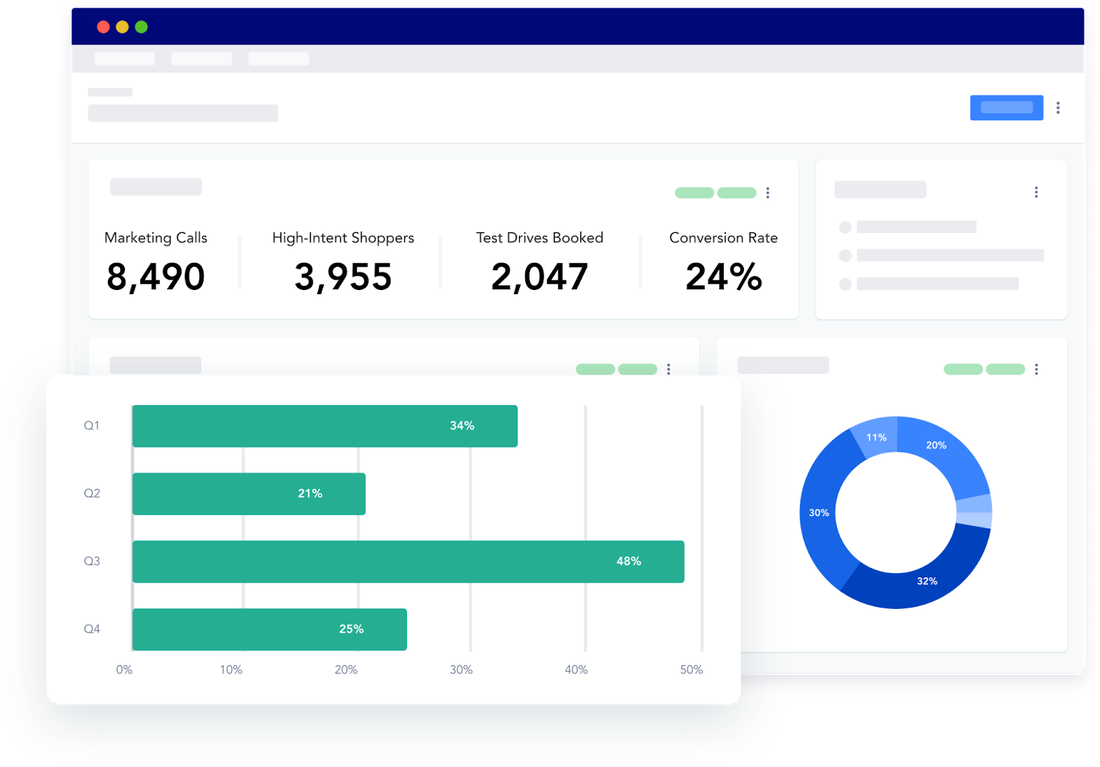
Are you facing the prospect of a significant squeeze on your marketing budget in the year ahead? You’re not alone. Many marketers across industries from automotive to retail are bracing for potential budget reductions amid ongoing economic uncertainty and changing consumer preferences and buying habits.
That’s why now is an ideal time for marketers to hunker down and focus more on identifying ways to improve marketing efficiency. Efficiency, sometimes also known as effectiveness, is the goal of many businesses that want to make the most of their resources, from working capital to human capital.
For marketing teams, the ability to work smarter and stretch every ad dollar to the max is critical to their success in times when the company is extra focused on watching the bottom line. However, increasing marketing efficiency is a valuable strategy for marketers operating in any economy, as it can boost the return on investment (ROI) for marketing campaigns — as well as the company’s revenue.
The goal of marketing efficiency is to reduce a marketing team’s overall costs while also achieving superior results. Marketing efficiency can be measured through metrics such as cost per acquisition (CPA) or customer acquisition cost (CAC). With the CPA metric, you’re calculating how much it costs to get a customer from the initial outreach phase to a conversion. And with the CAC metric, you’re measuring how much you’re spending on advertising and marketing to acquire a new customer.
Other metrics you can apply to track marketing efficiency include the click-through rate or CTR, which measures the number of customers who click through to your website or app following their exposure to a pay-per-click (PPC) advertising campaign.
There’s also the conversion rate, which marketers use to determine how many customers convert to the next stage of the buying journey, such as signing up for a trial or making a purchase. (In the automotive industry, for instance, the conversion rate can be used to track how many potential car buyers schedule a test drive after they’re targeted with a specific digital marketing campaign.)
To help you achieve the goals you set for marketing campaigns, increase ROI, and hopefully boost revenue, too, we’ve identified seven tips to consider applying as you develop marketing strategies that can help you improve marketing efficiency.
The first step toward developing any marketing campaign is to identify your goals and then select the metrics you’ll use to measure the campaign’s effectiveness in helping you reach them. Knowing which key performance indicators (KPIs) and metrics are the most relevant to track against your campaign can help you achieve a greater ROI.
One metric you may want to consider employing is the Marketing Efficiency Ratio or MER. MER takes total sales revenue for a specific period and divides it by your total marketing spend for that same period, deriving a ratio or rating that can indicate the efficiency of your marketing budget. MER is useful for gauging the success of a campaign at a high level.
Here’s a quick and simple explanation of how you can calculate MER: Say during one quarter you spend $30,000 on a media buy on various social media channels, and that investment yields a return of $50,000 in sales during that same period. Your marketing efficiency ratio for this marketing campaign would be 1.6.
The equation used to arrive at that figure for MER looks like this: $50,000 (total revenue) ÷ $30,000 (total ad spend) = 1.6 (MER). The MER result of 1.6 is the total average return on ad spend across all the social media channels used in your campaign. This figure can help you assess how efficiently your marketing efforts for the business are generating revenue over time.
Another helpful metric, mentioned earlier in this post, is CPA. This metric allows marketers to determine how efficient a campaign is by measuring the cost of acquiring one customer against the total marketing spend. The CPA metric also helps marketing teams extend their marketing budget further by allowing them to compare the effectiveness of various campaigns, so they can identify and focus more on the campaigns delivering a lower cost per acquisition.
Don’t forget the click-through rate (CTR) and conversion rate, which were referenced earlier in this post as well. Marketing teams can also measure customer engagement to improve marketing efficiency. For example, by tracking visitors to the website and which content creates the greatest response, marketers can repeat the use of strong content in key areas of the site to appeal to other potential customers.
Having reliable metrics to guide your marketing strategy will help you optimize your digital ad campaigns — and that means spending less to get more.
Consider this example: Before embarking on a PPC ad campaign, your marketing team conducts thorough keyword research, and they test the ad copy. But once the campaign is underway, it’s still challenging to determine if the campaign is effective at generating the desired ROI.
Now, let’s say you collect metrics at the midpoint of the PPC ad campaign that indicate the campaign is costing the business $20 per click for leads. By reviewing your previous campaign data, it may be possible to identify stronger and perhaps less costly keywords that deliver the same — or better — results for less money. (Presto! That’s marketing efficiency at work.)
Efficient marketing teams don’t put all their eggs in one basket. When crafting a digital marketing strategy, be sure that it includes multiple channels. After all, different channels can deliver different ROI.
For example, a display ad campaign from an auto dealership featuring a slick video of a hot new car roaring down the highway may produce a better ROI than a static email alerting potential buyers that the new car is now in stock. So, don’t be afraid to try different channels for maximum effect. Knowing which channels — or which mix of channels — are likely to produce the best results will further enhance your overall marketing efficiency and your team’s effectiveness.
A/B testing is a valuable data-driven tool for optimizing any digital marketing campaign. Think of it as content testing. You test two versions of an ad featuring different elements, like images, email subject lines, or calls to action, with the same audience to see which ad produces better results.
That insight on ad performance can help you refine and target your marketing outreach for greater effectiveness and efficiency and convert more customers. (Tip: It’s a good idea to practice continuous A/B testing so your campaign efforts stay on target.)
Use surveys to their fullest effect. It can be challenging to get users to complete surveys due to time drag and disinterest. So, when you do want to conduct a survey, be quick to ask for feedback, make it easy for the customer, and make it count. To improve your chances of engaging users, consider providing an incentive, like a discount code or a raffle prize.
Focus on user needs to produce the greatest response and most meaningful data set. What are your users really looking for? What are their biggest pain points? Gathering this intelligence can prove invaluable as you look to develop an efficient and effective marketing campaign.
Make a point to analyze spending and revenue at each stage of your marketing campaign. By gathering metrics throughout the sales funnel, you can identify the areas where you’re spending more but getting less in terms of return. You can also compare metrics from each marketing channel to determine if you’re getting the expected results and refine your campaigns throughout the sales funnel accordingly.
One of the savviest decisions you can make in the quest for marketing efficiency is to leverage the power of automation technology. There are many software programs out there that can automate marketing tasks and will integrate with the rest of your technology stack, including your customer relationship management (CRM) system. The beauty of many top solutions is that they also include analytical tools to help you measure campaign success.
If you use conversation intelligence technology from Invoca, for example, you can improve marketing efficiency by automating call analysis, listening, and dispositioning. And Invoca’s call tracking analytics capabilities can help your marketing team understand and engage more effectively with consumers at all points along the customer journey. You can also:
With these and other features from Invoca, you can get valuable insight into the voice of the customer (VoC) that will help you drive marketing campaign performance to new heights.
Call tracking technology from Invoca also helps marketers gain a more complete picture of how their digital campaigns are benefiting from call-based sales, enhancing marketing attribution.
Invoca generates dynamic phone numbers for inbound calls from website users. These are proxies which, just like clicks by website users, enable you to know the page the user was on when they dialed the phone. (This is vital insight for driving marketing efficiency, even though research shows that 62% of marketers fail to attribute revenue to inbound calls!)

Invoca helps businesses tie conversions and sales from inbound calls to the campaigns, ads, and search keywords that drove them through call tracking and conversational analytics. You can also see all online and offline conversions side by side, which can help you eliminate waste and reduce customer acquisition costs. In fact, independent research found that Invoca’s customers optimize their paid search campaigns by 25%, enabling $1.4 million in annual savings.
Marketers can improve their chances of achieving true marketing efficiency by taking advantage of the seven tips outlined above. As you create new marketing strategies in the year ahead, you may also want to review these examples of how companies are using call tracking and conversational analytics from Invoca to improve their marketing efficiency.
Want to learn more about how Invoca can help you spend smarter and boost your marketing ROI? Check out these resources:
The original version of this page was published at: https://www.invoca.com/blog/marketing-efficiency-boost-roi
Invoca for Healthcare enables healthcare providers to capture detailed analytics on a new patient’s full journey. This includes the marketing campaign that drove initial interest, the specific webp... Read more
Artificial intelligence (AI) is revolutionizing marketing. However, AI in marketing is about much more than automating tasks and processes. When marketing teams embrace AI, they gain ...read more
When the ball drops on New Year’s Eve, you probably won’t be thinking about snooze-worthy stuff like popping a new bottle of bubbly or smooching your sweetheart — ...read more
Anyone who has spent a little time in the SEO world knows that organic search is often the most significant driver of web traffic. It’s how most consumers discover your business, ...read more
Today’s marketers have more data about their consumers at their fingertips than ever before. Marketers who use these insights to create a data-driven strategy drive the best ...read more